
Mission Statement:
"To advance through research, education and symposia, an increased public awareness of the Cape Fear region's unique history."

Rockfish Creek:
Witness to History
Cape Fear Historical Institute Papers
Rockfish Creek today. General Hoke's troops were behind breastworks to the right, and Col. Thomas Lipcomb's cavalry
on the left and acting as a sreeen between the
North Carolinians and enemy skirmishers.
A mile to the rear of Hoke's defenses was Duplin Roads,
now the town of Wallace.
Rockfish Creek: Witness to History
The Lower Cape Fear, as its name implies, is that region which lies
near or adjacent to the lower reaches of the Cape Fear River and
its tributaries. One of the important Northwest Cape Fear branch tributaries is Rockfish Creek, which became the boundary between
New Hanover precinct and Duplin precinct, the latter established
on March 17, 1750 and named for George Henry Hay,
Lord Duplin. This boundary ran from the mouth of
Rockfish Creek eastward to the Oslow line and westward
to the upper forks of the Black River.
Abandoned railroad trestle support on north bank of
Rockfish Creek where General Hoke's defensive position
was located in February-March 1865.
Colonial Uprising:
By January 1776 armed colonial conflicts with British forces were finally
set in motion locally with Royal Governor Martin plans to subdue
"the impious and unnatural rebellion, and to restore the
just rights of His Majesty's Crown and Government, and the
liberties of his people."
On February 5, British Brigadier General Donald MacDonald isued
a call for a rendezvous of Loyalist forces near Rockfish Creek,
then a march in force to Brunswick County on the coast.
The response in the Lower Cape Fear was immediate, and the
First North Carolina Regiment under James Moore (part of the
Bladen Militia) took possession on February 15 of the bridge
over Rockfish Creek, seven miles below Cross Creek.
Moore's entrenched troops were soon joined by Colonel
Alexander Lillington and his 150 Wilmington District Militia;
Colonel James Kenan's 200 Duplin County Militia, and
Colonel Ashe's 100 volunteers from New Hanover County.
In addition, Colonel Richard Caswell was on his way with
800 men from New Bern.
By February 21, MacDonald crossed to the east side of the
Cape Fear to avoid open battle, sink their boats to discourage
pursuit and march southward to Wilminton to effect a junction
with Governor Martin's forces.
The pursuit of MacDonald would last a few days, culminating in his
defeat at Moore's Creek Bridge on February 27.
Wilmington was under British occupation in March 1781 as
Charles Cornwallis led his weakened army from Guilford Court
House and headed for Cross Creek (now Fayetteville) where
he expected supplies to be awaiting him from Colonel Nesbit
Balfour, British commander at Wilmington. With Cornwallis
was North Carolina Royal governor Josiah Martin, who
assured him of the loyalty of his subjects in the colony and
that "he would only have to appear...with his red coat and
epaulets to cause the loyalists to rise in such masses that the
rebels would be swept from the scene..." Few of his loyal
subjects were to be found, and Martin
soon returned to England.
Cornwallis rested his army at Wilmington, his headquartered
in the still-standing house at the corner of Third and Market
Streets. In an April 10th letter to Sir Henry Clinton, supreme
commander of British forces in North America, he "declared
that Virginia was far more suitable for offensive operations
than was North Carolina, where "numberless rivers and creeks"
made "interior navigation" virtually impossible."
In a letter to Major General William Phillips, he stated that
"By a war of conquest...to possess the country sufficiently
to overturn the Rebel government, and to establish a militia
and some kind of mixed authority of our own" would be
a ssuccessful strategy at this point.
Cornwallis and his army left Wilmington in mid-April for Virginia,
following the Old Duplin Road which roughly paralleled the
Northeast Cape Fear River, crossing Burgaw and Rockfish
Creeks to the Neuse River. The infamous Colonel Tarleton's
dragoons and mounted infantry accompanied Cornwallis on
the march, cutting a wide swath of destruction and
terrorizing the inhabitants -- something repeated in 1865.
.
The War Between the States:
After the fall of Forts Fisher and Anderson, only General
Robert F. Hoke's stubborn defensive line at Fork's Road
and defiant river batteries below Wilmington prevented
Northern gunboats from laying waste to the city. After the
fight at Town Creek which saw General Johnson Hagood
overwhelmed by a far more numerous enemy, Hoke fell
back into Wilmington at daylight on February 22, marching
throught the city amid burning military stores, then
commencing a fighting retreat as Northern troops
poured into Wilmington.
Ironically, Wilmington fell to the enemy on Washington's
Birthday, a general who led North Carolinians against an
enemy 85 years earlier; the enemy in 1865 was virtually
marching in the footsteps of Cornwallis's invaders of 1781.
The Raleigh Weekly Conservative praised Hoke's actions stating:
"The place was defended to the last and only evacuated when
the pressure of an overwhelming force of the
enemy rendered it necessary."
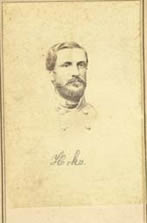
General Robert F. Hoke
of Lincolnton, North Carolina
Hoke's rearguard kept the enemy at bay while burning bridges
north of the city after his army had crossed, the last mile to
the river being "hotly contested" according to Drummer
Ludwig of the 8th North Carolina.
After the crossing, the North Carolinians deployed on
the north bank, erecting brestworks, while Hoke followed
the Wilmington and Weldon Railroad tracks for a crossing
of the Northeast Cape Fear River.
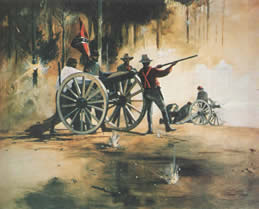
Ably covering the retreat was Battery A of the Third Battalion,
North Carolina Light Artillery under Lt. Alfred M. Darden.
This unit, known as the Northampton (county) Artillery, kept
a constant barrage upon the pursuing enemy as the North
Carolinians crossed the Northeast Cape Fear River at
Burgwyn's Hermitage Plantation, north of Wrightsboro on
Castle Hayne Road (Highway 117). Battery B (Edenton
Bell Battery) covered the retreat of General Hebert in the
same manner. These batteries were now under the overall
command of Wilmingtonian (Colonel) John J. Hedrick, and
absorbed into his 40th Regiment NC Troops.

Colonel John J. Hedrick of Wilmington
Supporting the artillery was the 61st North Carolina Regiment
of General Thomas Clingman's Brigade (commanded by Colonel
William Stewart Devane of Sampson County, which fought
stubbornly as the division made its way northward. General Hoke's
went into camp after nightfall north of the Northeast Cape
Fear River, just above present-day Castle Hayne, and
kept cavalry patrols out monitor any dangerous enemy
movments. Having no cavalry with them, the enemy was reluctant
to pursue Hoke and generally held its position at Northeast
Station on the Wilmington and Weldon Railroad. This is the
approximate location of the later prisoner exchange.
On the 61st North Carolina's rolls were many Cape Fear men,
including its first commander James D. Radcliffe, Quartermaster
Oliver Pendleton Meares, and Captain John F. Moore,
all Wilmingtonians, and Lt. Colonel Edward Mallett
of Fayetteville. The roster listed various companies
from the surrounding region: Sampson Confederates,
Beaufort Plow Boys, and men from Greene, Craven,
Chatham, Lenoir, Pitt, Wilson, Martin,
Onslow and Jones counties.
Truly a "War Between the States," these North Carolinians
were fighting invading troops from New York, Pennsylvania,
Indiana, Maine, Michigan, Connecticut, New Hampshire,
Illinois, and Ohio.
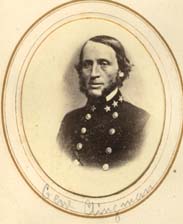
General Thomas Clingman
of Huntsville, North Carolina
Early the following morning (February 23), Hoke's men fired
several deadly volleys into the nearby trees to their rear to
discourage pursuit as they marched to the safety of Rockfish
Creek's opposite shore. Here they erected breastworks
and rested in camp for the next ten days and received
needed supplies at nearby Duplin Crossroads (present day
Wallace). The enemy was kept at bay by Col. Thmas
Lipcomb's Second South Carolina Cavalry which ranged
from Rockfish to the enemy's lines at the Northeast
Cape Fear River crossing.
Here General Hoke made arrangements for the exchange
of the many Northern prisoners he had with him. Short of
rations and unable to feed these burdens on his command,
Hoke had communicated with the enemy on February 22
to take these men:
"in the name of humanity [and] to consent to their delivery...
[that] they have been subjected to great suffering and
considerable mortality by the delay."
Northern commanders were reluctant to receive their own
captured soldiers as Northern General Grant had broken
off prisoner exchanges, despite the humanitarian reasons
Southern commanders were motivated
by to reduce the suffering of their many Northern
captives. They could truly barely feed themselves.
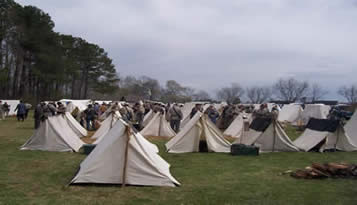
Encampment (reenactors) of North Carolina Troops
Lt. Zacheus Ellis of Battery B, 1st Battalion NC Heavy Artillery
wrote his mother from the Rockfish encampment, stating that
"I turned my back on our town, to see it no more, 'till after the
war." He wrote that "For the last three of four days, our
authority and the Yanks have ben engaged changing prisoners,
I understand we are to deliver 10,000 here and the
Yanks, the same number in Richmond. I received the
eatables, & I can tell you, enjoyed them, as our
eating is rather poor."
Ellis was killed in action at Bentonville March 19th.
General Hoke's troops braced themselves under heavy rains
on the 25, 26 and 27 of February, and departed their
Rockfish Creek encampment on March 4th to march toward
Kinston to oppose the enemy's advance from New Bern.
Arriving at Kinston on March 5th, they won a decisive victory
at the battle of Jackson's Mill and drove the enemy from the
field, but on March 8th, Hoke's assault on the enemy
at Wyse's Fork (Southwest Creek) was without success.
General Hoke was ordered to Goldsboro on March 12th,
then to Smithfield, then to Bentonville on March 19th to
reinforce General Joe Johnston's command.
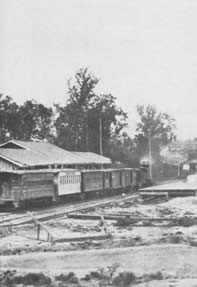
Hoke's Troops Depart Duplin Roads for Kinston By Rail
Sources:
The Lower Cape Fear in Colonial Days, L. Lee, UNC Press, 1965
General Robert F. Hoke, D. Broadfoot, J. Blair, 1996
War of the Rebellion Official Records, SII Vol. VII, GPO, 1899
Civil War in NC, Barrett, UNC Press, 1963
North Carolina in the Revolutionary War, Phillips Russell, 1965
Harnett, Hooper & Howe, Watson, Lawson, Lennon, 1979
North Carolina Troops, 1861-1865, W. Jordan, Jr., 1998
Southern Campaigns of the American Revolution, Morrill, 1993
©2006 Cape Fear Historical Institute